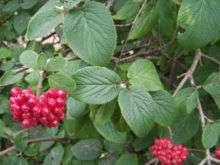Viburnum lantana
Viburnum lantana, the wayfarer or wayfaring tree, is a species of Viburnum, native to central, southern and western Europe (north to Yorkshire in England), northwest Africa, and southwestern Asia.[1][2][3] The vigorous deciduous European treelike shrub is common along waysides.
| Viburnum lantana | |
|---|---|
 | |
| Foliage and immature fruit | |
| Scientific classification | |
| Kingdom: | Plantae |
| Clade: | Tracheophytes |
| Clade: | Angiosperms |
| Clade: | Eudicots |
| Clade: | Asterids |
| Order: | Dipsacales |
| Family: | Adoxaceae |
| Genus: | Viburnum |
| Species: | V. lantana |
| Binomial name | |
| Viburnum lantana | |
Description
It is a deciduous shrub or small tree growing to 4–5 m (13–16 ft) tall. The leaves are opposite, simple oval to lanceolate, 6–13 cm (2.4–5.1 in) Long and 4–9 cm (1.6–3.5 in) broad, with a finely serrated margin; they are densely downy on the underside, less so on the upper surface. The hermaphrodite flowers are small, around 5 mm (0.20 in), and creamy-white, produced in dense cymes 4–10 cm (1.6–3.9 in) width at the top of the stems; they are produced in early summer, and pollinated by insects. The fruit is an oblong drupe 8 mm (0.31 in) long, green at first, turning red, then finally black at full maturity, and contains a single seed. The seeds are dispersed when birds eat the fruit, then deposit the seeds in another location in their droppings.[2][3]
An older name for the plant is hoarwithy. "Hoar" means grey-haired and refers to the hairs under the leaves, and "withy" means a pliant stem.[4]
Cultivation and uses
It is commonly grown as an ornamental plant for its flowers and berries, growing best on alkaline soils. A number of cultivars have been selected, including 'Aureum', with yellow leaves in spring.[3]
The fruit is mildly toxic, and may cause vomiting or diarrhea if consumed in large quantities.[5]
References
- Flora Europaea: Viburnum lantana
- Blamey, M. & Grey-Wilson, C. (1989). Flora of Britain and Northern Europe. ISBN 0-340-40170-2
- Huxley, A., ed. (1992). New RHS Dictionary of Gardening. Macmillan ISBN 0-333-47494-5.
- Reader's Digest Field Guide to the Trees and Shrubs of Britain p.87.
- Plants for a Future: Viburnum lantana
External links
